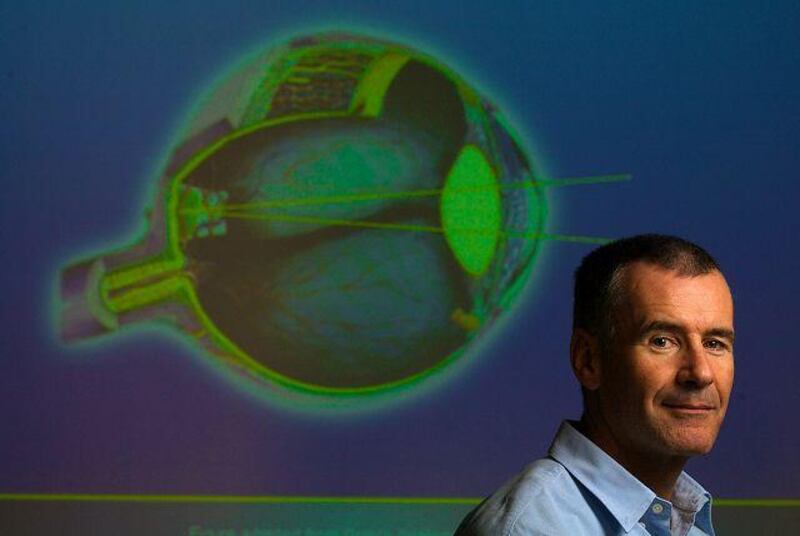SYDNEY // Australia is intensifying the international race to develop a bionic eye with the government in Canberra committing A$50 million (Dh143.7m) to help advance the pioneering technology. Two teams of Australian researchers are competing for the new finance. One group, Bionic Vision Australia, said its design was superior to those of its rivals from the United States, Germany and Japan. It is crafting a small video camera attached to a pair of glasses that transmits wireless video that is converted into tiny bursts of energy that stimulate electrodes in a bionic device. It would replace damaged light-sensing cells in the eye and would be surgically inserted to tissue behind the retina, a sensitive membrane where light is transformed into neural signals that the brain sees as visual images.
The second team is based at the Prince Alfred Hospital in Sydney. Its device is similar to the technology being developed by Bionic Vision Australia. "The retinal implant is to be an aid to navigation, to enable people to move around, to live independently," explained Tony Burkitt, from the University of Melbourne and a director of Bionic Vision Australia. He said that although definition and clarity provided by this first- generation model would be well short of normal sight, "with successive developments, people will be able to go on to read large print, but it is going to take probably 10 to 12 years until we get to the point of being able to identify faces".
The mechanism is fitted with 98 electrodes, while full-face recognition would need 10 times as many electrical conductors, which would amount to a monumental scientific leap. Bionic Vision Australia is a consortium of specialists who have the clinical expertise to build an artificial eye - called a retinal neuroprothesis - along with electrical engineers and those responsible for developing revolutionary cochlear implants that have allowed profoundly deaf people to hear.
"It is an enormous challenge," Dr Burkitt said. "The good thing is Australia has a rich history in medical bionics. The heart pacemaker was developed here and cochlear [the cochlear implant] is one of Australia's great success stories." With government funding, Australian scientists have said they are about two years away from experimenting with people suffering degenerative or inherited retinal disease.
Nigel Lovell, a professor from the University of New South Wales and a member of Bionic Vision Australia, said the prototype had "severe limitations" that would allow patients to see only bright patches of light. "If you think of a very old television screen with big dots and smear your eyes with Vaseline - it's those sorts of things [trial participants will see]. It'll be very crude dots of light spread over the visual field," cautioned Prof Lovell, who has spent the past decade working in this ground-breaking field where technology meets biology.
"It's absolutely limited. But we hold great hope that the brain will interpret the information in between those dots of light and as you move the camera and your eyes it will over-sample the image. This happens with bionic ears, with cochlear devices," he said. Scientists are relying on the brain to learn to interpret simple flashes of light as vision, essentially retraining the human mind to see again.
For those who have lost their sight, the visual cortex, the engine room of sight, is remodelled. Instead of processing information from the eyes, it decodes other sensory data from fingertips, where Braille, for example, is interpreted at the back of the brain rather than other areas associated with a sense of touch. "It is extraordinary just how plastic the brain is," Dr Burkitt said. "It can take the input it receives and extract the maximum amount of information from it. That is what we have learnt with the cochlear implant. It has only up to 22 electrodes and yet people can perceive quite sophisticated input. They can understand speech."
For blind people such as Wayne Hawkins, who lost his sight five years ago, the research and the promise of government assistance are giving them immense hope. "I think it's a brilliant idea," he said. "It's a really great way to keep progress going. It's really important for all aspects of research to be funded, particularly in this economic downturn. It was going to be particularly difficult for private financing to be found for this kind of research, so I think it's really imperative that the government does that."
The promise of grants worth millions of dollars would help Australian scientists compete with their US and German counterparts, who have enjoyed generous state funding in recent years, which has allowed them to start human trials. The effect this international research could have on the lives of many thousands of people could be profound. In Australia, 63 per cent of working-age people who are blind or visually impaired are either unemployed or underemployed.
The bionic eye also has the potential to help the disabled reclaim some simple pleasures. "I would love to be able to read the newspaper," Mr Hawkins said. "There is something that I really miss about sitting down on a Sunday with a cup of coffee, reading the newspaper." pmercer@thenational.ae





